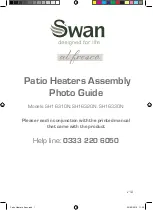
23
Water Piping
Chapter 4. – Installation
This appliance cannot be used for space heating applications only. Do not use this appliance if any part has been underwater.
Immediately call a qualified service technician to inspect the appliance and replace any part of the control system and gas control
which has been under water.
If the water heater is installed with a return line that includes backflow preventer, such as one having a backflow preventer in the cold
water supply line, means shall be provided to control thermal expansion. Contact the water supplier or a local plumbing inspector on
how to control this situation.
A pressure relief valve must be installed near the hot water outlet that is rated in accordance with and complying with either The
Standard for Relief Valves and Automatic Shutoff Devices for Hot Water Supply Systems, ANSI Z21.22, or ANSI/ASME Boiler and
Pressure Vessel Code, Section IV (Heating Boilers). This pressure relief valve must be capable of an hourly Btu rated temperature
steam discharge of 199,000 Btu/h. Multiple valves may be used. The pressure relief capacity must not exceed 150 psig. No valve shall
be placed between the relief valve and the water heater. The relief valve must be installed such that the discharge will be conducted
to a suitable place for disposal when relief occurs. No reducing coupling or other restriction may be installed in the discharge line. The
discharge line must be installed to allow complete drainage of both the valve and the line. If this unit is installed with a separate storage
vessel, the separate vessel must have its own temperature and pressure relief valve. This valve must also comply with The Standard
for Relief Valves and Automatic Gas Shutoff Devices for Hot Water Supply Systems, ANSI Z21.22. (in the U.S. only). A temperature
relief valve is not required, but if one is used, do not install the valve with the probe directly in the flow of water. This may cause
unwarranted discharge of the valve.
Piping and components connected to the water heater shall be suitable for use with potable water. Toxic chemicals, such as those used
for boiler treatment, shall not be introduced into the potable water. A water heater used to supply potable water may not be connected
to any heating system or components previously used with a nonpotable water heating appliance.
When water is required in one part of the system at a higher temperature than in the rest of the system, means such as a mixing valve
shall be installed to temper the water to reduce the scald hazard.
• Flush water through the pipe to clean out metal powder, sand and dirt before connecting it.
• Perform the following insulation measures for prevention of freezing.
1. Take appropriate heat insulation measures (e.g., wrapping with heat
insulation materials, using electric heaters) according to the climate
of the region to prevent the pipe from freezing.
2. Make sure that there are no water leaks from the cold and hot water
supply pipes, then insulate the pipes completely.
3. Be sure to also completely insulate the water supply valve and the
cold and hot water connections on the water heater (refer to the
figure on the right).
4. Do not cover the water drain plug with insulation so that water in the
pipe can be drained. (Refer to the figure in the right.)
• Use a union coupling or flexible pipe for connecting the pipes to reduce the force applied to the piping.
• Do not use piping with a diameter smaller than the coupling.
• When feed water pressure is too high, insert a pressure regulating valve, or take water hammer prevention measure.
• Avoid using joints as much as possible to keep the piping simple.
• Avoid piping in which an air holdup can occur.
• If installing the unit on a roof:
About lower-level hot water supply.
If the unit is installed on a roof to supply water to the levels below, make sure that the water pressure supplied to the unit does not
drop below 29 psi. It may be necessary to install a pump system to ensure that the water pressure is maintained at this level.
Check the pressure before putting the unit into operation.
Failure to supply the proper pressure to the unit may result in noisy operation, shorter lifetime of the unit, and may cause the unit to
shut down frequently.
4-4. Water Piping
Installation must be performed by a qualified plumber. In the Commonwealth of Massachusetts, this
product must be installed by a licensed plumber or gas fitter in accordance with the Massachusetts
Plumbing and Fuel Gas Code 248 CMR Sections 2.00 and 5.00. Observe all applicable codes.
Summary of Contents for Eco TOUGH NRCP111-DV-LP
Page 42: ...42 Memo ...
Page 43: ...43 Memo ...
















































